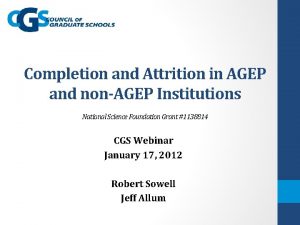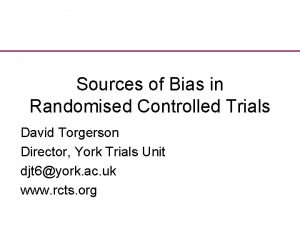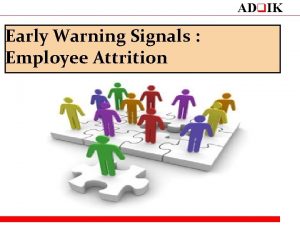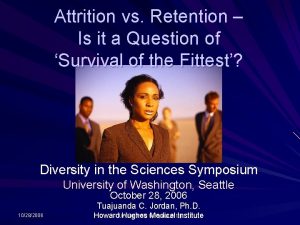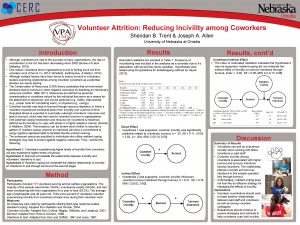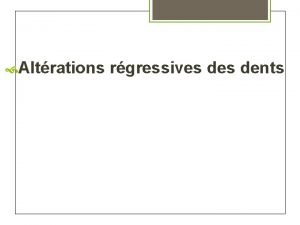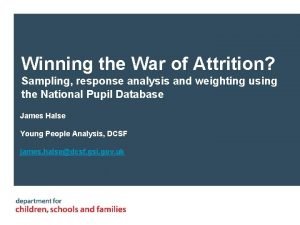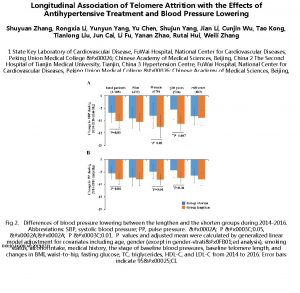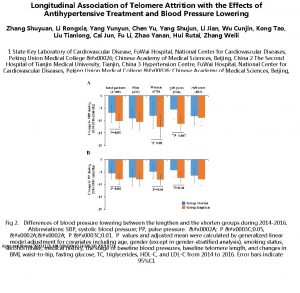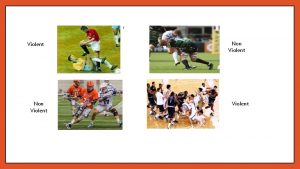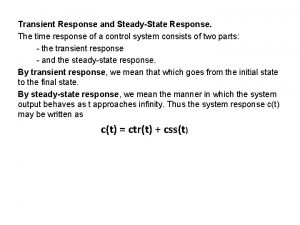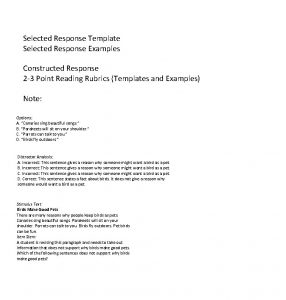Effects of Attrition and Non Response in the




















- Slides: 20

Effects of Attrition and Non. Response in the HRS Pierre-Carl Michaud Arie Kapteyn James P. Smith Arthur van Soest

What are the Questions? What is the impact of attrition in the HRS? -on current cross-sections - on longitudinal analysis What is the role of “ever out”? 2 3/23/09

DATA • Original 1992 age eligible HRS cohort up to 2004 wave 3 3/23/09

• A Short Detour on Baseline Non. Response Not our focus in this paper but everything is obviously conditional on this • HRS attempts to ‘match’ the CPS by weighting- uses age, gender, race, ethnicity, household composition, and PSUs 4 3/23/09

Baseline Non-Response 5 3/23/09

Baseline Comparisons of HRS and CPS • After weighting, baseline HRS and the CPS match very well, which is not much of a surprise- but it also matches well on variables not in the weights • Of course, CPS is not necessarily the truth, beauty, and the American way- especially for some types of key HRS content 6 3/23/09

Four Types of Subsequent Non. Response Studied – Always in the Study – Always in – Out at least once but back in 2002 Ever out – Died Prior to 2004 - Died – Left and not back in 2004 - Attritors 7 3/23/09

Baseline Characteristics by Type of Participation Sequence 1992 -2004 (weighted using Baseline HRS weights) Between 24. 9 and 42. 9% of ever out came back, since 96 8 3/23/09

Mortality in HRS 9 3/23/09

Baseline Characteristics by Type of Participation Sequence 1992 -2004 (weighted using Baseline HRS weights) Characteristics Always In Ever Out Died Attritors Total Demographics in 1992 Age (yrs) Female (%) Born outside U. S. (%) African American (%) Hispanic (%) Married (%) Widow(er) (%) 55. 5 55% 9% 9% 5% 78% 6% 54. 9 50. 2 15. 6 15. 0 14. 1 73. 2 5. 7 56. 4 43% 7% 26% 8% 66% 10% 55. 5 52. 2 12. 9 9. 0 7. 2 78. 2 4. 7 55. 6 52% 10% 6% 77% 6% Health Status in 1992 Health fair/poor (%) 16% 20. 8 47% 16. 1 20% SES and Employment Status in 1992 College and above % Own house (%) Working (%) Retired or disabled (%) 21% 84% 68% 16% 15. 2 73. 4 69. 6 10. 9 12% 72% 49% 30% 16. 8 83. 5 68. 8 15. 8 19% 81% 66% 17% 10 3/23/09

Baseline Wealth Distribution by Type of Response 1992 -2004 (thousands of dollars) (weighted using Baseline HRS weights) Household Wealth in 1992 Mean 10 th pctile 25 th pctile Median 75 th pctile 90 th pctile 276 7. 0 55. 9 150. 6 319. 8 606. 2 Ever out but in for 2004 281. 6 0 17. 3 98. 5 242 660. 4 Died prior to 2004 181. 2 0 10. 8 82. 6 199. 2 389. 7 Attritor 270. 1 8. 1 58. 7 151. 3 329. 9 650. 2 Total 222. 7 45. 3 134 299. 8 591. 3 Always in 11 3/23/09

Baseline Income Distribution by Type of Response 1992 -2002 (thousands of dollars) (weighted using Baseline HRS weights) Household Income in 1994 Mean 10 th pctile 25 th pctile Median 75 th pctile 90 th pctile Always in 69. 1 14. 0 29. 7 54. 9 87. 7 131. 6 Ever out but in for 2004 68. 8 10. 6 23. 9 48 79. 9 117. 2 Died prior to 2004 48. 5 7. 2 15. 9 33. 3 62. 6 97. 4 Attritor 68. 6 13. 8 30. 1 53. 3 80. 2 128. 7 Total 66. 2 12 26. 6 51. 1 82. 5 126. 2 12 3/23/09

Multinomial Logits for Panel Inclusion- selective variables, females 13 3/23/09

Multinomial Logits for Panel Inclusion- selective variables, males 14 3/23/09

Use inverse probability weights • For example: the weights for the sample including ever out and always in: • where – a is always in – e is ever out – d is died 15 3/23/09

Effects of Weighting on Household Wealth: Samples Excluding and Including Ever out Sequences (thousands of dollars) Statistic (percentile) Household Wealth in 2004 10 th 25 th Median 75 th 90 th Only “always in” (attrition weights correct for “ever out” and “attritors”) Unweighted 3. 8 55. 5 179. 0 448. 0 875. 0 HRS-92 7. 4 69. 0 213. 2 500. 0 969. 2 IPW (both ever out and attrit. ) 5. 6 64. 0 203. 4 488. 0 951. 2 HRS-04 7. 3 69. 8 213. 5 500. 0 977. 0 “Always in” and “Ever out” sample (attrition weights correct for “attritors” only) Unweighted 2. 0 48. 8 166. 6 430. 0 864. 0 HRS-92 5. 0 61. 5 200. 1 487. 0 967. 5 IPW (only attritors) 5. 0 62. 3 200. 5 487. 0 966. 0 HRS-04 5. 0 62. 0 200. 0 487. 0 969. 2 16 3/23/09

Fixed Effects Regression for Log-Wealth z-diff tests difference with first column Last two columns also differ significantly 17 3/23/09

Conditional Logits for Home Ownership z-diff tests difference with first column 18 3/23/09

Conditional Logits for Labor Force Participation z-diff tests difference with first column 19 3/23/09

Conclusions • Cross-sectional HRS analysis in 2004 seems ok with current weights • Keeping the ever out in is particularly important for the analysis of wealth and income • Balanced samples should be used with caution (e. g. wealth and labor force participation) 20 3/23/09
 Doctoral initiative on minority attrition and completion
Doctoral initiative on minority attrition and completion Attrition in ww1
Attrition in ww1 Transportation rocks
Transportation rocks Attrition bias
Attrition bias Attrition bias
Attrition bias Attrition bias
Attrition bias Early warning attrition tracker excel
Early warning attrition tracker excel Chapter 8 sentence check 1 answers key attrition
Chapter 8 sentence check 1 answers key attrition Hotel roi model secondary
Hotel roi model secondary Types of attrition
Types of attrition Attrition vs retention
Attrition vs retention Attrition prediction model in excel
Attrition prediction model in excel Volunteer attrition
Volunteer attrition Attrition dentaire
Attrition dentaire Attrition bias
Attrition bias Natural and forced response
Natural and forced response First order system transfer function
First order system transfer function A subsequent
A subsequent Un appel vient pour des soldats
Un appel vient pour des soldats Effects of non inclusive practice
Effects of non inclusive practice N
N
